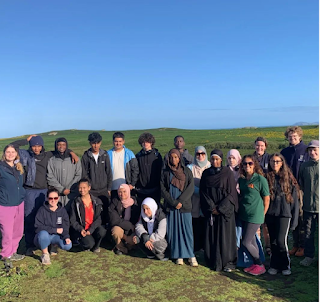As summer comes to a close and autumn migrations (and weather!) begin, August is a time of pivotal change on Skomer. Auks like the Puffins, Razorbills, and Guillemots are now a rare sighting, but they’ve been replaced by murmurations of Starlings and visiting migrants like Blackcaps and Robins. A lot of island attention now turns to our sheltered coves for seal pups and to events like Black 2 Nature!
 |
| A gorgeous yellow sunset seen from the Garland Stone |
With the first two pups spotted in Matthew's Wick on the 6th August, seal season is officially underway on Skomer! Increasing numbers of pregnant females are spotted hauling themselves out onto their favourite low tide spots such as the Garland Stone and Rye Rocks in North Haven. The Neck and the main island are now being surveyed at low tide every 3 days to count the pups which will continue until the end of September.
 |
A large bull Grey Seal spotted resting in Kittiwake Cove |
This month, Skomer has been blessed with gorgeous warm and dry
late-summer evenings which have provided fruitful moth trapping! We were
joined by the Perseid meteor shower and even the northern lights on the 11th
August where we caught 24 different species including a rather regal Oak Eggar
moth pictured below. Weekly volunteers and hostel guests were blown away by the
diversity and subtle beauty of Skomer’s moth community, all thanks to the
fantastic identification skills of Assistant Warden Ceris and LTV Nick!
 |
A female Oak Eggar moth posing on egg boxes from our moth trap |
In other exciting news, Skomer has been host to a group of extremely enthusiastic teenagers this past week as part of a Black 2 Nature residential. Black 2 Nature (B2N) is a charity dedicated to connecting visibly minority ethnic (VME)) kids with nature and improving equal access to natural spaces. As part of their stay, we involved B2N guests with as many of our favourite island activities as possible, including weighing Manx Shearwater chicks alongside OxNav students, seal watching, and even a quiz including points for best bird call impressions!
The B2N group enjoying the sunshine on Skomer
Great Black-Backed Gull Diet Study
One of Skomer’s seabird researchers, Will, has been monitoring the Great Black-Backed Gulls (along with a handful of other species!) from nest site to fledgling. As well as this productivity research, LTVs Nick and Pete have helped Will rummage through this season’s abandoned nests in search of clues into the chick’s eating habits.
 |
Will (left) and Nick (Right) discussing the contents of a Great Black-Backed Gull chick pellet |
 |
An extremely fresh Great Black-Backed Gull pellet containing mostly vegetable matter |
- Pete (Skomer LTV)
 |
| Northern Lights (Aurora Borealis) seen from the Harold Stone |











